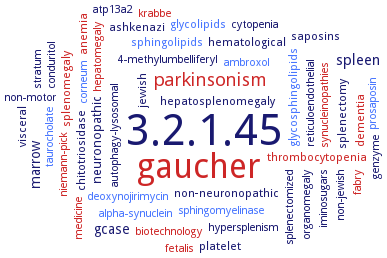3.2.1.45: glucosylceramidase
This is an abbreviated version!
For detailed information about glucosylceramidase, go to the full flat file.

Word Map on EC 3.2.1.45 
-
3.2.1.45
-
gaucher
-
parkinsonism
-
spleen
-
marrow
-
gcase
-
neuronopathic
-
chitotriosidase
-
saposins
-
visceral
-
hematological
-
jewish
-
non-neuronopathic
-
sphingolipids
-
ashkenazi
-
thrombocytopenia
-
glycolipids
-
dementia
-
splenectomy
-
anemia
-
platelet
-
splenomegaly
-
hepatosplenomegaly
-
glycosphingolipids
-
autophagy-lysosomal
-
non-motor
-
corneum
-
synucleinopathies
-
genzyme
-
conduritol
-
organomegaly
-
alpha-synuclein
-
ambroxol
-
medicine
-
hepatomegaly
-
fabry
-
splenectomized
-
iminosugars
-
krabbe
-
taurocholate
-
niemann-pick
-
stratum
-
prosaposin
-
biotechnology
-
non-jewish
-
sphingomyelinase
-
atp13a2
-
deoxynojirimycin
-
hypersplenism
-
fetalis
-
cytopenia
-
reticuloendothelial
-
4-methylumbelliferyl
- 3.2.1.45
- gaucher
- parkinsonism
- spleen
- marrow
- gcase
-
neuronopathic
- chitotriosidase
-
saposins
- visceral
-
hematological
-
jewish
-
non-neuronopathic
- sphingolipids
-
ashkenazi
- thrombocytopenia
- glycolipids
- dementia
-
splenectomy
- anemia
- platelet
- splenomegaly
-
hepatosplenomegaly
- glycosphingolipids
-
autophagy-lysosomal
-
non-motor
- corneum
- synucleinopathies
- genzyme
-
conduritol
-
organomegaly
- alpha-synuclein
- ambroxol
- medicine
- hepatomegaly
- fabry
-
splenectomized
-
iminosugars
- krabbe
- taurocholate
- niemann-pick
-
stratum
- prosaposin
- biotechnology
-
non-jewish
- sphingomyelinase
-
atp13a2
- deoxynojirimycin
-
hypersplenism
- fetalis
-
cytopenia
-
reticuloendothelial
-
4-methylumbelliferyl
Reaction
Synonyms
ABG, acid beta-D-glucosidase, acid beta-glucocerebrosidase, acid beta-glucosidase, acid beta-glucosylceramidase, acid beta-glycosidase, acid glucosylceramidase, acid-beta-glucocerebrosidase, acid-beta-glucosidase, Alglucerase, beta-D-glucocerebrosidase, beta-GC, beta-glucocerebrosidase, beta-glucosidase, beta-glucosidase 2, beta-glucosylceramidase, beta-glucosylceramidase 2, beta-glycosylceramidase, bile acid beta-glucosidase, ceramidase, glucosyl-, ceramide glucosidase, cerebroside beta-glucosidase, Ceredase, Cerezyme, D-glucosyl-N-acylsphingosine glucohydrolase, GBA, GBA1, GBA2, Gcase, GCD, GCR, GDA, gene-activated human GlcCerase, Glc-Cerase, glcCer-beta-glucosidase, GlcCerase, glucocerebrosidase, glucocerebroside beta-glucosidase, glucose cerebrosidase, glucosphingosine glucosylhydrolase, glucosylceramidase, glucosylceramide beta-glucosidase, glucosylcerebrosidase, glucosylsphingosine beta-D-glucosidase, glucosylsphingosine beta-glucosidase, glycosylceramidase, glycosylceramide-beta-glucosidase, Imiglucerase, Klotho-related protein, KLrP, lysosomal glucosylceramidase, microsomal bile acid beta-glucosidase, N-acylsphingosyl-1-O-beta-D-glucoside:glucohydrolase, neutral beta-glycosylceramidase, neutral glucosylceramidase, NLGase, non-lysosomal beta-glucosylceramidase, non-lysosomal glucosylceramidase, nonlysosomal beta-glucosidase, nonlysosomal glucosylceramidase, psychosine hydrolase, taliglucerase alfa, velaglucerase alfa, Vpriv


 results (
results ( results (
results ( top
top





